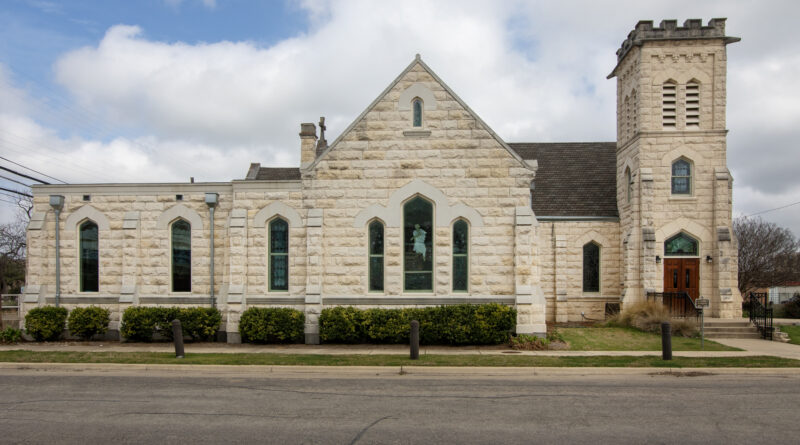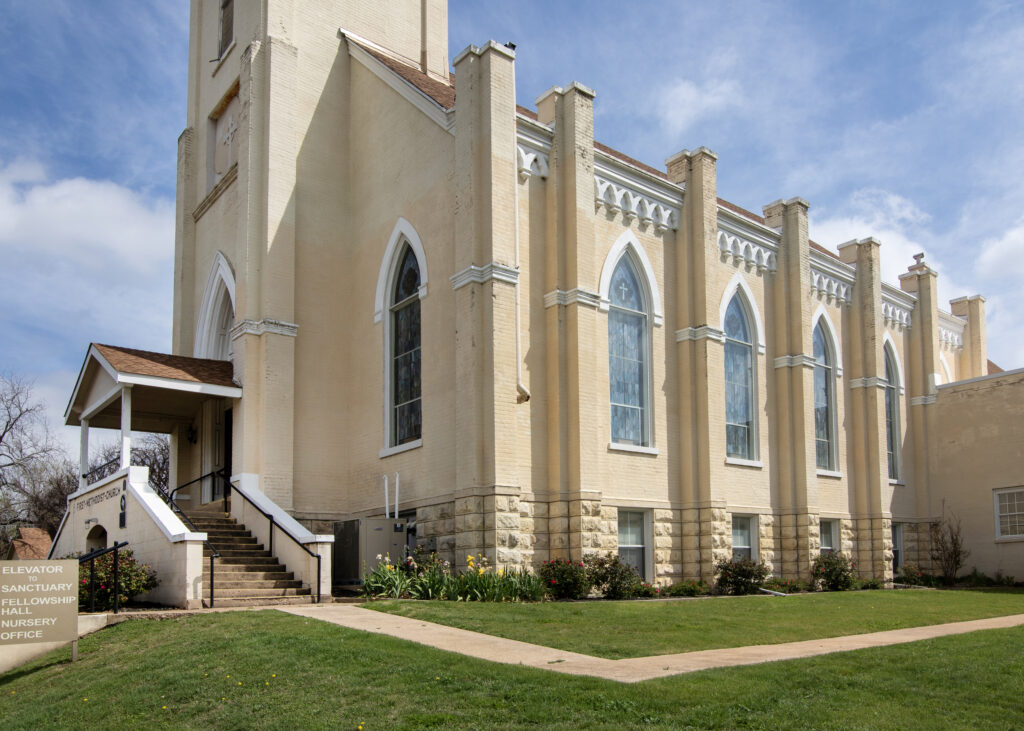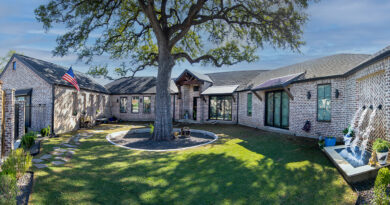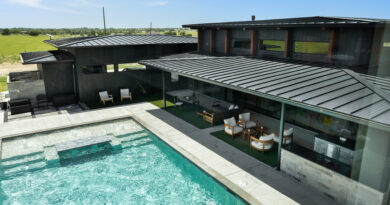On Firm Foundations
By PATRICIA BENOIT | Photos by SKEEBO
Editor’s note: Easter Sunday is the biggest day of the year for churches. As the church pews fill up, we thought it would be a perfect time to share the architectural history of some of Bell County’s oldest places of worship.
CHRIST EPISCOPAL
The glowing white lilies blooming along the perimeter of Christ Episcopal Church’s Gothic architecture are fragrant hints of the lilies inside along the altar rails on Easter Sunday morning.
The Episcopalians’ house of worship, constructed in 1905, is the second oldest in Temple. The congregation is the oldest continuously meeting group in the city, officially beginning in 1883, with evidence of an Episcopal fellowship in early 1882. The church bell has tolled for every service since 1910.
At first, the fledgling congregation struggled financially. To save money, discarded steel railroad tracks were used in the church’s foundation and still support the flooring today.
Austin architect Arthur Osborn Watson in 1905 created Christ Episcopal Church as an eclectic, intimate worship space reflecting the congregation’s historic English-Anglican heritage.
The rusticated white Austin limestone stonework and distinctive stained-glass windows give the impression of an English country church.
Inside, the dark woodwork, pews and altar reveal definite early 20th-century arts-and-crafts styling popular in Temple at the turn of the century. The interior has a homey character emphasizing a warm, welcoming ambiance appreciated by Central Texans.
Christ Episcopal differs from other ecclesiastical buildings of its time with one important feature: While other denominational designs center on the pulpit and preaching, Christ Church’s architecture focuses on communion (the Eucharist) and the altar. Since its earliest beginnings, the congregation has had a high regard for contemplative worship in classical settings.
About 20 years ago, the church underwent massive expansion and renovation to meet the needs of its flourishing congregation. Respecting Watson’s original design, architects used the same stone from the original 1905 quarry in Liberty Hill, thus, the extension seamlessly flows into the original edifice.
EIGHTH STREET BAPTIST
Like a mighty rock, Eighth Street Baptist Church in Temple has stood firm in the faith and a beacon of hope to African Americans.
In 1882, Rev. Lewis W. Mackey arrived in Temple and founded what is now Eighth Street Baptist Church. The nation was barely 15 years away from the Civil War. Mackey sensed a larger mission as freemen came to work on the railroads, so he named his new congregation Saint Love All Baptist Church, reflecting his optimism.
Saint Love All had gained a solid toehold, attracting African American members from all economic strata — doctors, lawyers, business owners, teachers, railways workers and laborers. During the 1890s, Saint Love All became the site for denominational conventions attracting up to 800 visitors.
By 1905, the congregation built a spacious wood-frame building distinguished by a towering steeple. Renovations followed in 1911, when the congregation’s name was formally changed to Eighth Street Baptist. By 1930, the steeple was removed, the exterior was bricked, and a basement and roof garden were added.
In recent years, members launched outreach ministries to the home-bound and elderly, youth programs and Bible studies.
“Our challenge is to be the ‘church,’” the Rev. Dock Ulysses Reese Sr., pastor from 1968-1976, said. “Not a club for friends. Not an institute for establishing ideas. Not a school perpetuating methods, but a church that lifts Jesus so that he can draw men unto himself.”
FIRST UNITED METHODIST BELTON
Shortly after Bell County was created out of Milam County in 1850, the Methodists sensed a widening mission field into the Blackland prairie.
In November 1850, the Methodist Episcopal Church, South, (the church’s official name then) purchased a lot in the newly organized county seat for “a house or place of worship.” It was an audacious step because Bell County at the time was on the farthest reaches of the Texas frontier — wild, unsettled and sparsely populated.
Circuit riding preachers filled the pulpits on Sundays, first in a grove of trees, until a suitable building could be found. The congregation gathered in several temporary buildings until in the late 1850s, when it built permanent hewn-cedar quarters with no flooring at Pearl and First Avenue.
By the 1880s, membership had outgrown its site, so from 1884-86 a larger Gothic-style sanctuary was constructed at 205 N. East St. with locally produced bricks and native stone foundation. Notable was its towering steeple, pointing to heaven. The new building with its distinctive tower and bell became a Central Texas landmark, nicknamed “the cathedral church of the Northwest Texas Conference.” Ten-foot-tall metal finials with crosses atop the pilasters added majesty to the design.
The new location was a blessing. Baylor Female College moved nearby to Belton in 1886; First Avenue running east from the courthouse quickly became the town’s most important shopping street. Most of the town’s prominent residences were also located in surrounding neighborhoods.
By 1925, infrastructure issues forced removal of the steeple and metal finials. In 1950, when the congregation observed its centennial, 11 families donated memorial windows, serving as visible links to the congregation’s historic roots, its Christian heritage and present-day expanding mission.
The Texas Historical Commission designated First United Methodist as a Recorded Texas Historic Landmark in 1978.
If you know of an interesting Bell County home or building Tex Appeal readers would like to look inside, email editor@texappealmag.com.






